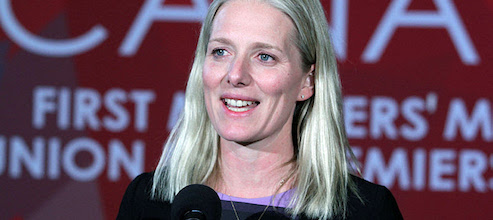
Why carbon pricing and rebates to oil companies go hand in hand
We want firms to get cleaner, not smaller. So we should help those most exposed to competitiveness pressures caused by carbon pricing.
Canadian provinces are actively moving toward putting a broad-based price on greenhouse gas emissions. At the same time, some of them are providing cash rebates back to businesses in emissions-intensive sectors. This combination of policy actions is sometimes viewed as bizarre, one that undermines the basic logic of carbon pricing. But it actually makes a great deal of sense.
Research by Canada’s Ecofiscal Commission, which I chair, identified the portions of the economy that are “emissions intensive” and “trade exposed” (EITE)—and therefore face serious “carbon competitiveness” pressures. Firms in these EITE sectors do any one of a number of things, including the production of cement, fertilizer, and paper; petroleum refining and bitumen upgrading; manufacturing steel and aluminum; mining for coal and base metals; and the extraction of oil and natural gas.
Across the country as a whole, production in these sectors amounts to about five per cent of our economy, but it is unevenly spread across the provinces. Production in the EITE sectors represents only one to two per cent of GDP in Ontario and Quebec, but approximately 18 per cent of GDP in both Alberta and Saskatchewan.
When designing a carbon-pricing policy, governments are wise to pay special attention to these sectors, as failing to do so may lead the business to leave Canada for a country with less stringent policy. The result, known in economic jargon as “leakage,” would be no overall change in global greenhouse gas emissions but a decline in economic activity and jobs in Canada. This would be both bad economic policy and ineffective environmental policy.
The goal of well-designed climate policy in Canada should be to keep all of our businesses reducing their GHG emissions, but not by shrinking their scale and laying off workers or by moving their operations to some other jurisdiction. We want them to get cleaner, not smaller.
Canadian provincial governments thus need to address two separate economic challenges when designing their emissions-reducing policies. First, they should use policies that reduce emissions at the lowest-cost possible. Second, they should ensure the competitiveness of our business sector.
These two objectives are not the same. The quest for lowest-cost emissions reductions reflects a concern for the entire economy. The issue of business competitiveness matters across the economy, too, but it is only the EITE parts of the economy that are significantly affected by any province’s climate policy.
Two distinct challenges
Facing these two distinct challenges, governments need two separate policy instruments. The first is a broad-based carbon price, which sends a clear economic signal to consumers and businesses to reduce their GHG emissions. Not only can a carbon price reduce emissions, but economists broadly agree that it is the lowest-cost way of doing so. The Ecofiscal Commission’s report The Way Forward shows that the economic benefit of using carbon pricing over “command and control” regulations is almost four per cent of national income. That’s roughly the size of the 2008-09 recession, but it counts each and every year the policies are in place. That’s a huge economic case in favour of carbon pricing.
The second required policy instrument is one that provides financial support to the firms most exposed to competitiveness pressures caused by carbon pricing. Free permits in a cap-and-trade system (as in Ontario and Quebec) or the proposed “output based allocations” to firms in Alberta are both excellent examples. In each case, the financial support goes straight to firms’ bottom lines, maintaining their profitability and competitiveness—but only if they remain economically active in their home province.
The combination of these two policy instruments offers an effective one-two punch to achieve the two different policy objectives. The economy-wide carbon price will drive emissions reductions at the lowest overall cost; and targeted financial support to the emissions-intensive sectors will protect their business competitiveness, even while the carbon price provides them with an incentive to reduce their emissions.
Governments across this country need to find ways to reduce GHG emissions without threatening Canadians’ economic prosperity. And carbon competitiveness issues are far too important to be swept under the carpet. But heads-up policy design can give us the best of both worlds: low-cost GHG reductions and domestic firms that are competing successfully in a tough global economy. That’s a winning combination.
This piece was originally published by The Hill Times on March 8, 2017.




Comments are closed.